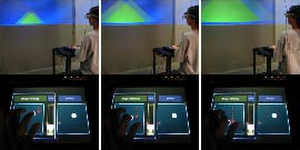Information
- Publication Type: Conference Paper
- Workgroup(s)/Project(s):
- Date: August 2008
- ISBN: 978-3-540-85410-4
- Series: LNCS
- Publisher: Springer
- Location: Rennes, France
- Lecturer: Kresimir Matkovic
- ISSN: 0302-9743 (Print) 1611-3349 (Online)
- Booktitle: Proceedings of SmartGraphics 2008, Springer LNCS 5166/2008
- Keywords: Virtual environments, Finger-walking, Navigation, Traveling techniques, Multi-touch device
Abstract
In this paper we present a Finger Walking in Place (FWIP) interaction technique that allows a user to travel in a virtual world as her/his bare ¯ngers slide on a multi-touch sensitive surface. Traveling is basically realized by translating and rotating the user's viewpoint in the virtual world. The user can translate and rotate a viewpoint by mov- ing her/his ¯ngers in place. Currently, our FWIP technique can be used to navigate in a plane but it can be extended to navigate in the third axis, so that the user can move to any direction in a 3D virtual world. Since our FWIP technique only uses bare ¯ngers and a multi-touch de- vice, ¯nger motions are not precisely detected, especially compared with the use of data gloves or similar sensing devices. However, our experi- ments show that FWIP can be used as a novel traveling technique even without accurate motion detection. Our experiment tasks include ¯nding and reaching the target(s) with FWIP, and the participants successfully completed the tasks. The experiments illustrate our e®orts to make the FWIP technique robust as a scaled-down walking-in-place locomotion technique, so that it can be used as a reliable traveling technique.Additional Files and Images
Weblinks
No further information available.BibTeX
@inproceedings{Kim-2008_FWIP,
title = "Finger Walking in Place (FWIP): a Traveling Technique in
Virtual Environments",
author = "Ji-Sun Kim and Denis Gracanin and Kresimir Matkovic and
Francis Quek",
year = "2008",
abstract = "In this paper we present a Finger Walking in Place (FWIP)
interaction technique that allows a user to travel in a
virtual world as her/his bare ¯ngers slide on a multi-touch
sensitive surface. Traveling is basically realized by
translating and rotating the user's viewpoint in the virtual
world. The user can translate and rotate a viewpoint by mov-
ing her/his ¯ngers in place. Currently, our FWIP technique
can be used to navigate in a plane but it can be extended to
navigate in the third axis, so that the user can move to any
direction in a 3D virtual world. Since our FWIP technique
only uses bare ¯ngers and a multi-touch de- vice, ¯nger
motions are not precisely detected, especially compared with
the use of data gloves or similar sensing devices. However,
our experi- ments show that FWIP can be used as a novel
traveling technique even without accurate motion detection.
Our experiment tasks include ¯nding and reaching the
target(s) with FWIP, and the participants successfully
completed the tasks. The experiments illustrate our e®orts
to make the FWIP technique robust as a scaled-down
walking-in-place locomotion technique, so that it can be
used as a reliable traveling technique.",
month = aug,
isbn = "978-3-540-85410-4",
series = "LNCS",
publisher = "Springer",
location = "Rennes, France",
issn = "0302-9743 (Print) 1611-3349 (Online)",
booktitle = "Proceedings of SmartGraphics 2008, Springer LNCS 5166/2008",
keywords = "Virtual environments, Finger-walking, Navigation, Traveling
techniques, Multi-touch device",
URL = "https://www.cg.tuwien.ac.at/research/publications/2008/Kim-2008_FWIP/",
}




